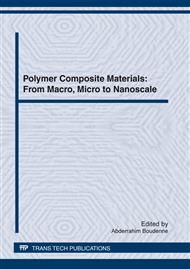[1]
Treacy, M. M. J., Ebbesen, T. W. and Gibson, J. M. (1996) Exceptionally high Young's modulus observed for individual carbon nanotubes, Nature, 381, 678-680.
DOI: 10.1038/381678a0
Google Scholar
[2]
Cooper, C. A., Young, R. J. and Halsall, M. (2001) Investigation into the deformation of carbon nanotubes and their composites through the use of Raman spectroscopy, Composites Part A: Applied Science and Manufacturing, 32, 401-411.
DOI: 10.1016/s1359-835x(00)00107-x
Google Scholar
[3]
Peigney, A., Laurent, Ch., Flahaut, E., Bacsa, R. R. and Rousset, A. (2001) Specific surface area of carbon nanotubes and bundles of carbon nanotubes, Carbon, 39, 507–514.
DOI: 10.1016/s0008-6223(00)00155-x
Google Scholar
[4]
Yokozeki, T., Iwahori, Y., Ishiwata, S. and Enomoto, K. (2007) Mechanical properties of CFRP laminates manufactured from unidirectional prepregs using CSCNT-dispersed epoxy, Composites Part A: Applied Science and Manufacturing , 38, 2121-2130.
DOI: 10.1016/j.compositesa.2007.07.002
Google Scholar
[5]
Hu, N., Li, Y., Nakamura, T., Katsumata, T., Koshikawa, T. and Arai, M. (2011).
Google Scholar
[6]
Wicks, S. S., de Villoria, R. G. and Wardle, B. L. (2010) Interlaminar and intralaminar reinforcement of composite laminates with aligned carbon nanotubes, Composite Science and Technology, 70, 20-28.
DOI: 10.1016/j.compscitech.2009.09.001
Google Scholar
[7]
Gojny, F. H., Wichmann, M. H. G., Fiedler, B. and Schulte, K. (2005) Influence of different carbon nanotubes on the mechanical properties of epoxy matrix composites - A comparative study, Composites Science and Technology, 65, 2300–2313.
DOI: 10.1016/j.compscitech.2005.04.021
Google Scholar
[8]
Yu, N., Zhang, Z. H. and He, S. Y. (2008) Fracture toughness and fatigue life of MWCNT/epoxy composites, Materials Science and Engineering: A, 494, 380-384.
DOI: 10.1016/j.msea.2008.04.051
Google Scholar
[9]
Lachman, N. and Wagner, D. H. (2010) Correlation between interfacial molecular structure and mechanics in CNT/epoxy nano-composites, Composites Part A: Applied Science and Manufacturing, 41, 1093-1098.
DOI: 10.1016/j.compositesa.2009.08.023
Google Scholar
[10]
Ganguli, S., Bhuyan, M., Allie, L. and Aglan, H. (2005) Effect of multi-walled carbon nanotube reinforcement on the fracture behavior of a tetrafunctional epoxy, Journal of Materials Science, 40, 3593-3595.
DOI: 10.1007/s10853-005-2891-x
Google Scholar
[11]
Zhang, W., Picu, R. C. and Koratkar, N. (2007) Suppression of fatigue crack growth in carbon nanotube composites, Applied Physics Letters, 91, 193109.
DOI: 10.1063/1.2809457
Google Scholar
[12]
Wernik, J. M. and Meguid, S. A. (2010) Recent developments in multifunctional nanocomposites using carbon nanotubes, Applied Mechanics Reviews, 63, 050801.
DOI: 10.1115/1.4003503
Google Scholar
[13]
Gojny, F. H., Wichmann, M. H. G., Köpke, U., Fiedler, B. and Schulte, K. (2004) Carbon nanotube-reinforced epoxy-composites: enhanced stiffness and fracture toughness at low nanotube content, Composites Science and Technology, 64, 2363-2371.
DOI: 10.1016/j.compscitech.2004.04.002
Google Scholar
[14]
Ma, P. C., Siddiqui, N. A., Marom, G. and Kim, J. K. (2010) Dispersion and functionalization of carbon nanotubes for polymer-based nanocomposites: A review, Composites Part A: Applied Science and Manufacturing, 41, 1345-1367.
DOI: 10.1016/j.compositesa.2010.07.003
Google Scholar
[15]
Kelly, A. (1973) Strong solids, 2nd ed., Oxford: Clarendon Press, 228.
Google Scholar
[16]
Hull, D. and Clyne, T. W. (1996) An introduction to composite materials, 2nd ed., Cambridge: Cambridge University Press, 31.
Google Scholar
[17]
Yakobson, B. I., Campbell, M. P., Brabec, C. J. and Bernholc, J. (1997) High strain rate fracture and C-chain unraveling in carbon nanotubes, Computational Materials Science, 8, 341-348.
DOI: 10.1016/s0927-0256(97)00047-5
Google Scholar
[18]
Wang, C. Y. and Zhang, L. C. (2008) An elastic shell model for characterizing single-walled carbon nanotubes, Nanotechnology, 19, 195704.
DOI: 10.1088/0957-4484/19/19/195704
Google Scholar
[19]
Ru, C. Q. (2000) Effect of van der Waals forces on axial buckling of a double-walled carbon nanotube, Journal of Applied Physics, 87, 7227–7231.
DOI: 10.1063/1.372973
Google Scholar
[20]
Cumings, J. and Zettl, A. (2000) Low-friction nanoscale linear bearing realized from multiwall carbon nanotubes, Science, 289, 602-604.
DOI: 10.1126/science.289.5479.602
Google Scholar
[21]
Pantano, A., Parks, D. M. and Boyce, M. C., (2004) Mechanics of deformation of single- and multi-wall carbon nanotubes, Journal of the Mechanics and Physics of Solids, 52, 789-821.
DOI: 10.1016/j.jmps.2003.08.004
Google Scholar
[22]
Ru, C. Q. (2001) Degraded axial buckling strain of multiwalled carbon nanotubes due to interlayer slips, Journal of Applied Physics, 89, 3426–3433.
DOI: 10.1063/1.1347956
Google Scholar
[23]
Pregler, S. K. and Sinnott, S. B. (2006) Molecular dynamics simulations of electron and ion beam irradiation of multiwalled carbon nanotubes: The effects on failure by inner tube sliding, Physical Review B, 73, 224106.
DOI: 10.1103/physrevb.73.224106
Google Scholar


